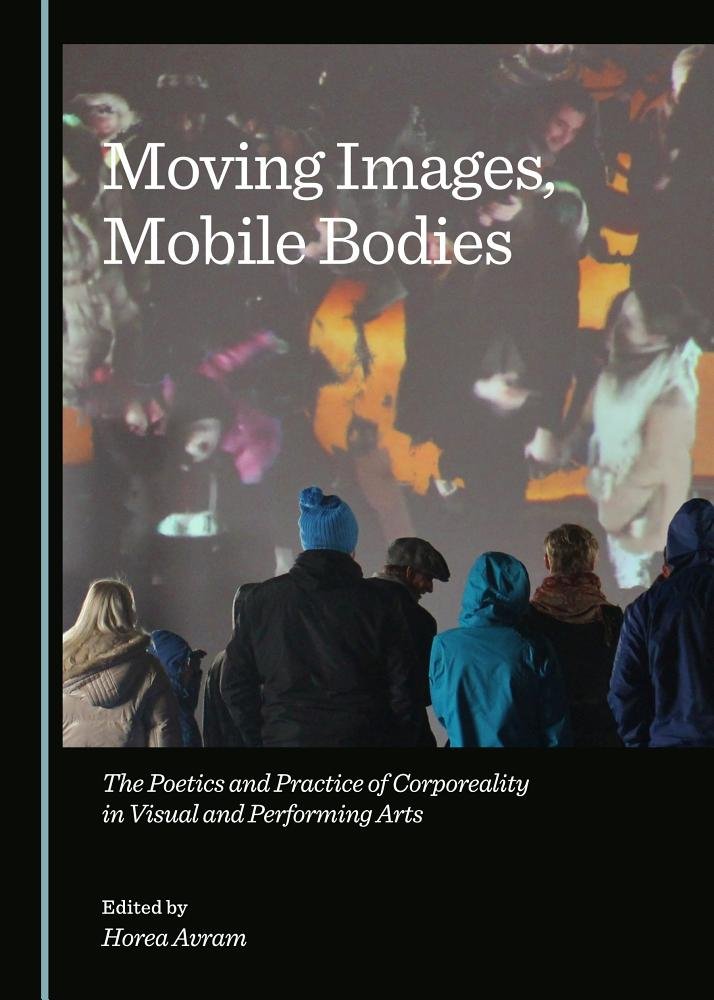In his introduction to the book, Horea Avram points to the core of essays in this publication: “the intricate encounters and interplay between image and body, between visuality and corporeality, between movement and mobility.” By pointing to these terms, he tends to give notice to the various concepts and fields of research being entangled and therefore emphasizing the malleable, evolving, or as the book’s title suggests, moving and mobile entities. It seems a transitional quality is overcoming the essentialist attitude toward the media and questioning their “essence.” Avram sees an etymological connection between “image” and “body” both sharing a sort of bodily perception. He goes further and, quoting Hans Belting, outweighs body to the image: “Images do not exist outside the body; they are light focused onto retina… [Images] do not exist by themselves, but they happen; they take place whether they are moving images or not. They happen via transmission and perception.” Or more strictly speaking, quoting Sean Cubitt: “Things are invisible: what we see is not things but light (…) What we witness is instead the becoming-visible of light.” So, image should be considered as non-present entity that itself gives a presence or re-presents something.
In a historical approach, Avram debates transformations of the concept of image ranging from Plato’s superior position for “idea” and the inferiority of image to the object (which causes nothing but illusion) to the postmodern, poststructuralist theory of Jean Baudrillard who criticizes any referentiality in image or such concepts as original and copy. It seems Baudrillard surpasses body and image both and gives way to “reality without reality” better known as a “hyperreality.” A land of simulacra, or “domain of images” according to James Elkin, full of signs, spectacles, images and the play between all. Avram’s discussion nonetheless surrender to the fact that the images can both manipulate and affect human’s life by producing the real.
In the second part of his discussion, Avram pays to the mobile quality of the visual objects and the notion of “moving image” and, beyond pure visuality and integral to it, he ties the moving image up with “time”: “it is multimodal, multimedial and multisensorial.” Moving image might not simply be a “plural of static image” or that “circulates,” he points to a third one—“an image that changes its morphology, texture, the viewing angle, or the relationship with the context; an image with an extended temporality.” Regarding this attitude, one should agree then with the incongruities like Peter Kubelka claiming “Cinema is not movement, cinema is a projection of stills,” or Bill Viola’s rejection of still image and assertion that “[…] at any given moment a complete image does not exist at all.” Perhaps the best notion, as Avarm agrees with Noel Carroll, is to understand moving image as “a series of different visual situations that engage the perception in progress.”
So we should admit that it is a world of pictorial turn we live in and not, according to W.J. T. Mitchell, a naïve mimesis or representation but rather “a postlinguistic, postsemiotic rediscovery of a picture as a complex interplay between visuality, apparatus, institution, discourse, bodies and figurality.” Avram, seems to agree with Michel Foucault in seeing body both natural/biological and cultural. In a pictorial turn crisis, the process of imaging is an integral part of the world—it does not “double” the world but creates the world performing as an image. It is in such a world that the body adopts essential agency itself working as an imaged or imagined image “positive, negative, symbolic, material, carnal, aesthetic, metaphysical, social, political, etc.” The concept “body without organ” by Gilles Deleuze and Félix Guattari is a similar double-dimension state of the body being biological but with virtual potentials. Avram attributes the anti-essentialist and social constructivist feminist theories by Judith Butler and Elizabeth Grosz to the same new context of the corporeality. Therefore, he is not willing to side with Marshall McLuhan’s optimism toward technological expansion as extension of body’s senses. Contrarily, by applying the postmodern term “disembodiment,” he reminds alienation of the body.
Contemporary art practices are centered around this problematic and they are instead of static techniques created by mobile bodies or “subjective, flexible, interactive and contingent” practices with “networked, open-ended, fluid and multiple experiences” rather than clear-cut productions. Avram translates this by the cynical solution Slavoj Žižek proposes, that is a paradoxical act to cope with a void of direct contact with the reality: “so as to embody, to internalize and anthropomorphize media objects.” The essays in the book put finger on corporeality and with a discursive and theoretical approach raise critical questions about the significance of such artistic practices.
_
Avram, Horea, ed. Moving Images, Mobile Bodies: The Poetics and Practice of Corporeality in Visual and Performing Arts. New Castle: Cambridge Scholars Publishing, 2018.
 platform
platform  Moving Images, Mobile Bodies: The Poetics and Practice of Corporeality in Visual and Performing Arts
Moving Images, Mobile Bodies: The Poetics and Practice of Corporeality in Visual and Performing Arts


